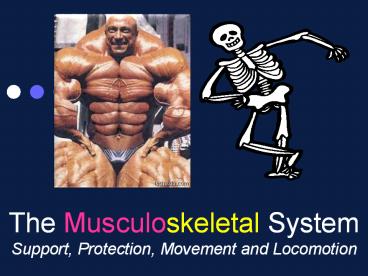The Musculoskeletal System Support, Protection, Movement and Locomotion PowerPoint PPT Presentation
Title: The Musculoskeletal System Support, Protection, Movement and Locomotion
1
The Musculoskeletal SystemSupport, Protection,
Movement and Locomotion
2
Functions
- Motion
- Maintenance of posture
- Heat production
- Protection of internal organs
3
Origin of muscle tissue
- Forms from the mesoderm germ layer
- Triploblasts? simplest flatworms
- Segmentation ? annelids, arthropods, vertebrates
4
Types of muscle tissue
- Skeletal
- Attached to bones
- Striated and voluntary
- Cardiac
- Heart wall
- Highly branched
- Striated and involuntary
- Smooth
- Walls of hollow internal structures
- Nonstriated and involuntary
- Striated
- Voluntary movements
- Longitudinal or circular in shape
- Smooth
- Involuntary movements
- Vertebrate muscles
- Invertebrate muscles
5
Muscle action
- Motion produced by action of muscles on bones ?
levers - Tendons ? attach muscles to bones (e.g. Achilles
tendon) - 1 fixed point of attachment (origin) and 1 moving
point of attachment (insertion) - Fascia ? sheets that cover muscles
- Muscles work in antagonistic or opposing pairs
6
Organization of skeletal muscles
7
Overview of the Sliding Filament Theory
The muscle fiber is stimulated.
Ca2 ions are released.
Thin filaments move to middle of sarcomere.
Muscle fiber contracts.
Muscle tension increases.
8
(No Transcript)
9
(No Transcript)
10
(No Transcript)
11
Muscle twitch
- Cycle of contraction and relaxation generated
from one stimulus - All or none response of muscle fibers
- Force Summation
- Increasing and size of fibers contracting
- Increasing frequency at which action potentials
are sent to muscle fibers
12
Slow and Fast Twitch Fibers
- Slow Twitch
- More ATP from aerobic respiration
- Continuous extended contractions over time
- More myoglobin
- Fast Twitch
- Anaerobic metabolism (creatine phosphate and
lactic acid fermentation) - Short bursts of speed
- Fatigue quickly
13
Muscle and exercise
14
(No Transcript)
15
Cramps
- Painful sensations caused by contraction/
- overshortening of muscles
- Causes
- Hyperflexion
- Inadequate oxygenation
- Changes in temperature
- Dehydration
- Low amount of electrolytes in blood
- Treatment
- Correct breathing
- Increasing intake of water and electrolytes
PowerShow.com is a leading presentation sharing website. It has millions of presentations already uploaded and available with 1,000s more being uploaded by its users every day. Whatever your area of interest, here you’ll be able to find and view presentations you’ll love and possibly download. And, best of all, it is completely free and easy to use.
You might even have a presentation you’d like to share with others. If so, just upload it to PowerShow.com. We’ll convert it to an HTML5 slideshow that includes all the media types you’ve already added: audio, video, music, pictures, animations and transition effects. Then you can share it with your target audience as well as PowerShow.com’s millions of monthly visitors. And, again, it’s all free.
About the Developers
PowerShow.com is brought to you by CrystalGraphics, the award-winning developer and market-leading publisher of rich-media enhancement products for presentations. Our product offerings include millions of PowerPoint templates, diagrams, animated 3D characters and more.

